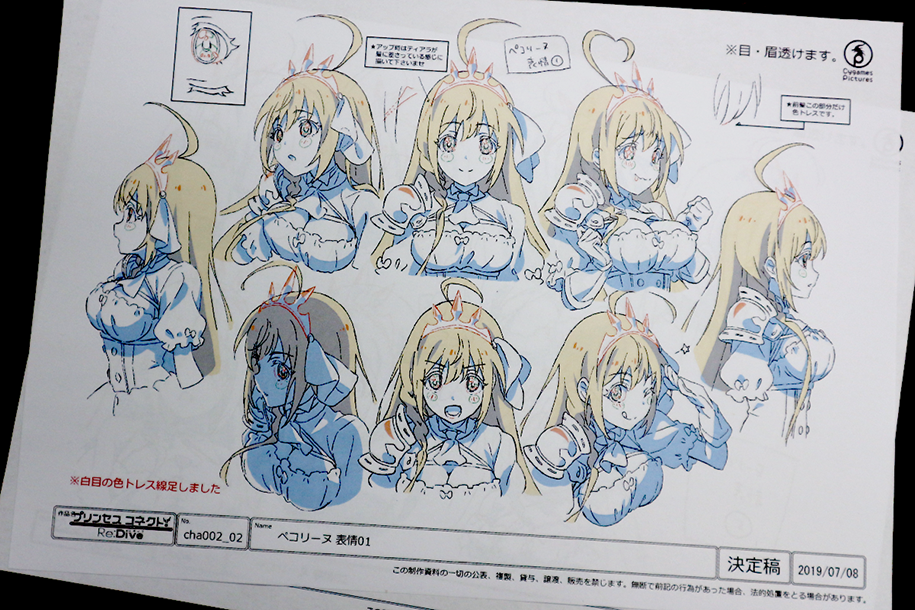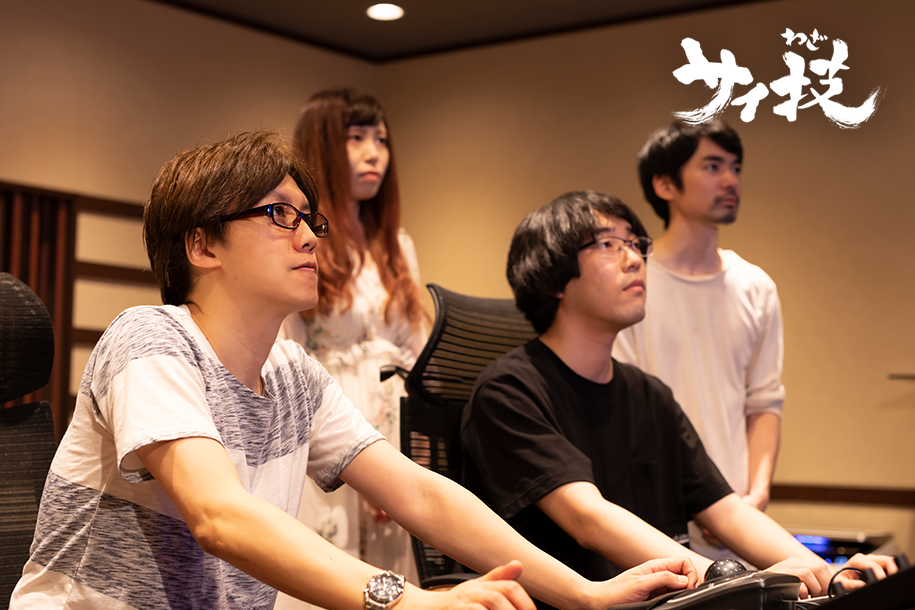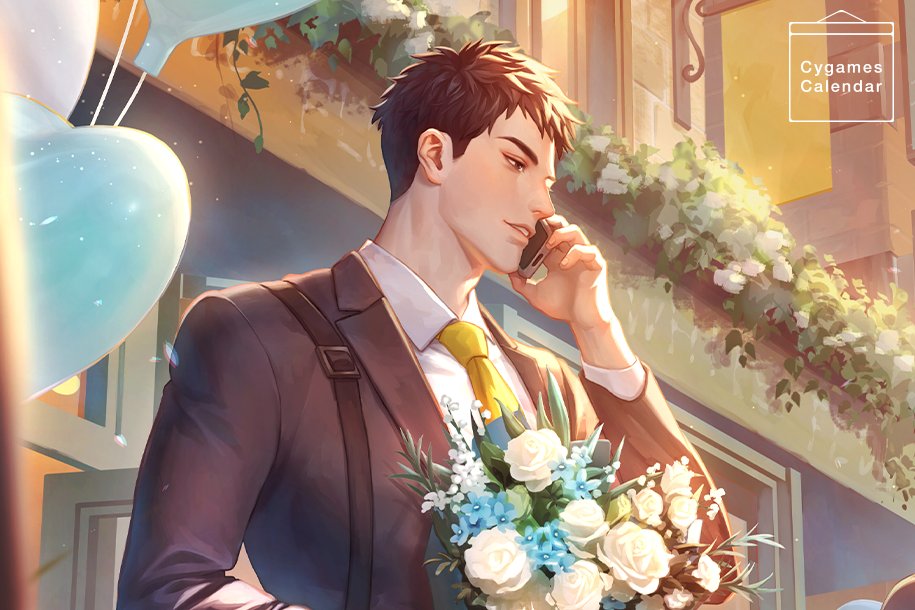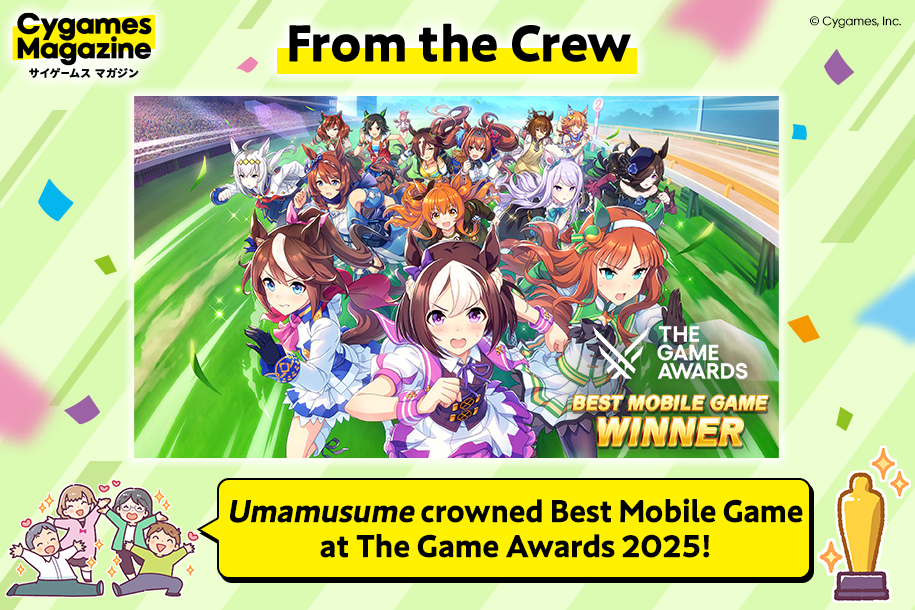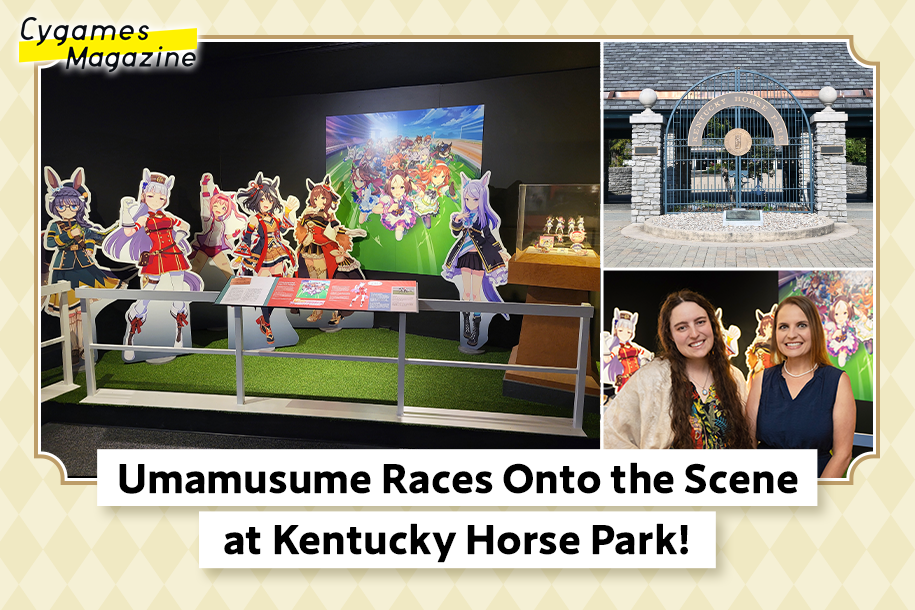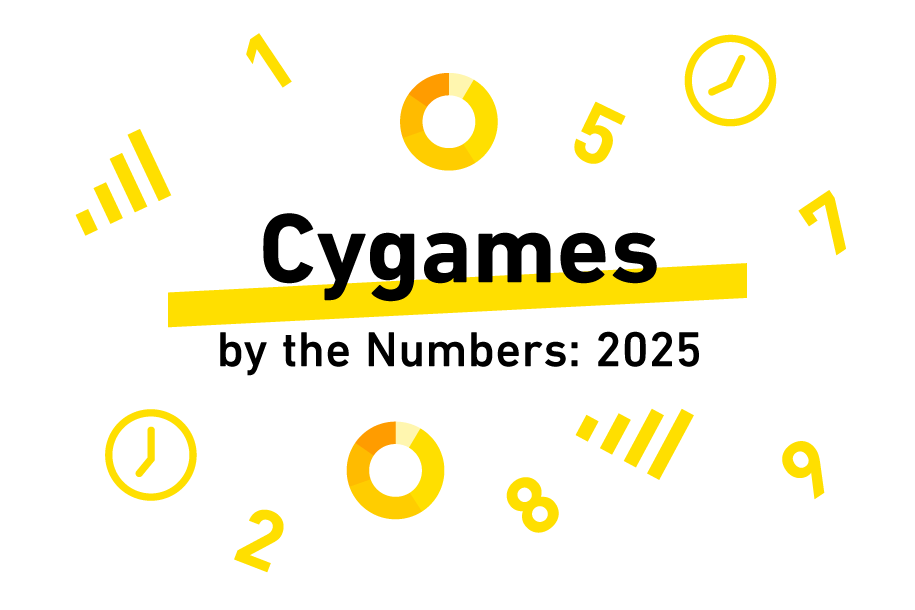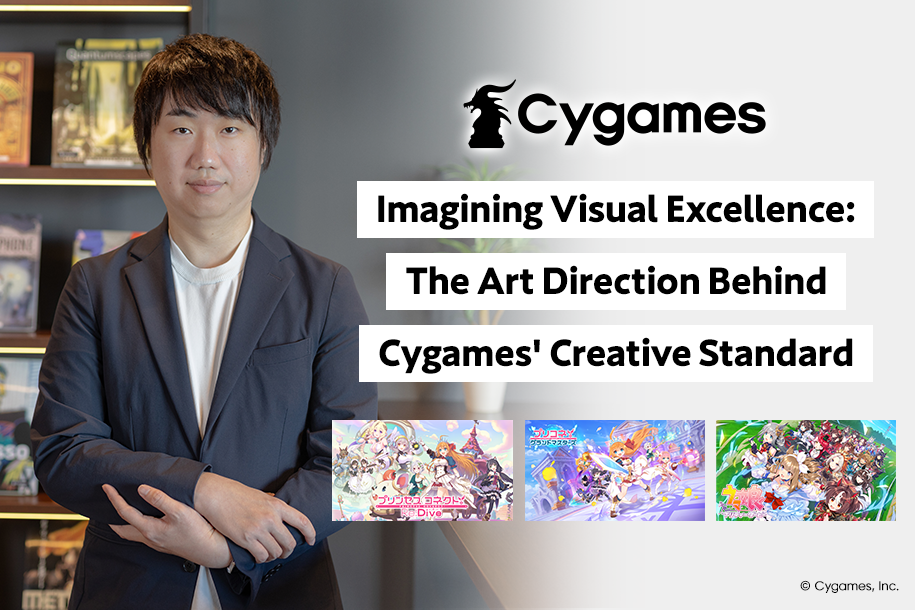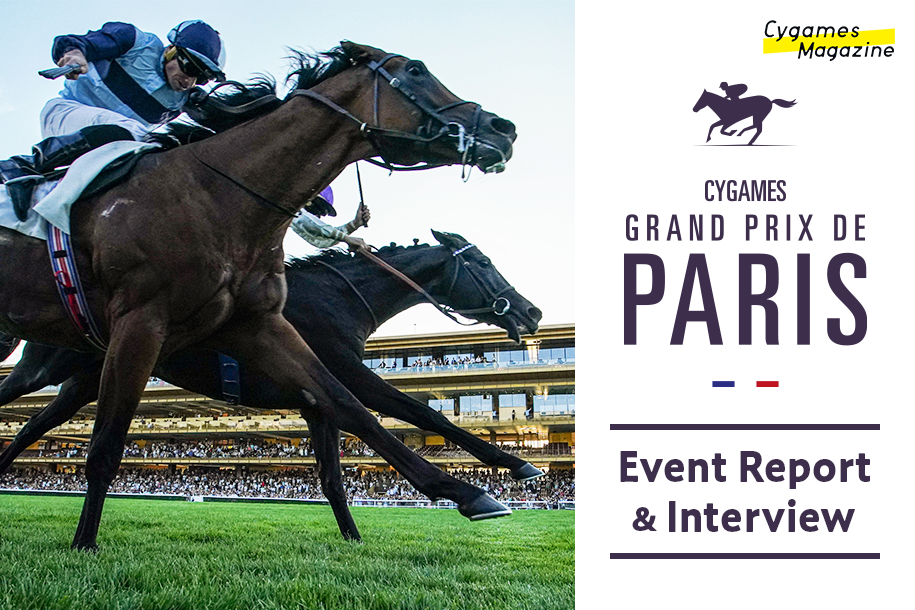Q&A with the Princess Connect Re: Dive Art Team! Part 1: Always Be Playful! On the spirit of a creator and producing 120% quality works
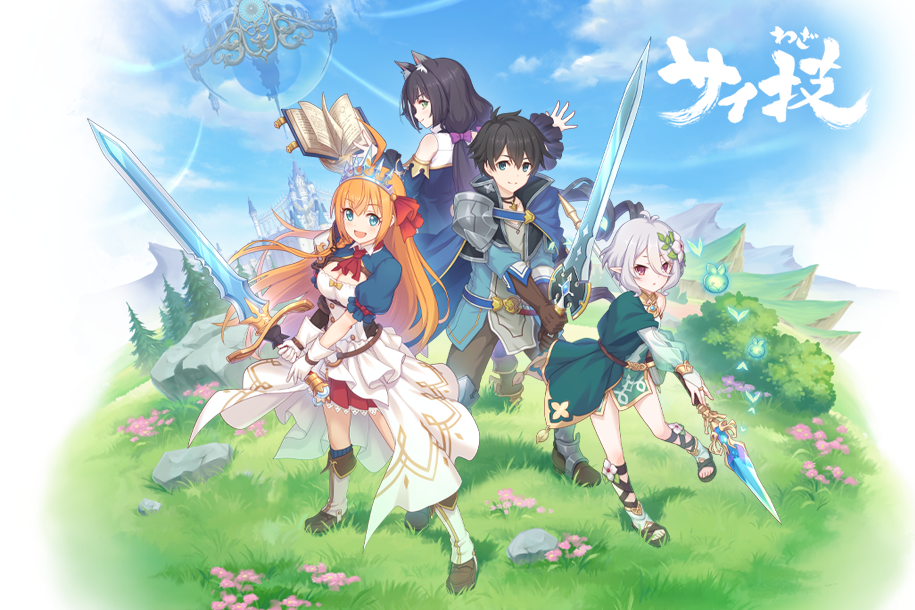
“Princess Connect! Re: Dive” (PCR) recently had its second anniversary.
As part of the “CySkill” project at Cygames Magazine, we interviewed the team of illustrators and animators behind PCR! In this article, we asked the art team about how the PCR world was created, focusing primarily on its main story and story events.
In Part 2, we talk about the future of PCR too, so don’t miss out on both of these insightful features!
- Art Team LeadWao
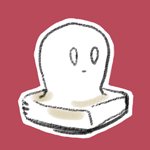
- Wao joined a game development company as a fresh-faced university graduate, then later used that wealth of experience with console and social games to join Cygames in 2014. He oversees a vast amount of illustrations in Princess Connect! Re: Dive, from the characters to the monsters that they fight. His current job as the team leader has him working hard to supervise the team’s members while encouraging their growth.
- Art Team Monster Department LeadMasatake

- Masatake leapt right into a job at Cygames after he graduated in 2015. When he was assigned to work on Princess Connect! Re: Dive, he was tasked with leading the monster department, where the various beasts and critters of the world are designed. He supervises all the monster design work that’s included in the game.
- Art Team BG Department LeadNatsuko
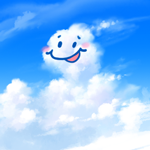
- Natsuko joined Cygames after working in the anime industry on background and scenery art. Now she works on Princess Connect! Re: Dive as the leader of the game’s background art division. She oversees all the background art produced for use in the game.
- Art Team Animation Department General Animation DirectorNaoko
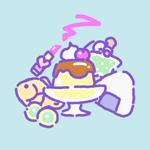
- Naoko came to Cygames with ten years of animation experience under her belt. Her work in Princess Connect! Re: Dive largely consists of supervising the direction of framing the game’s animated scenes, as well as the general quality of those scenes. She’s also involved in character design work for the game’s anime spin-off.
The art team’s workflow: what it takes to create graphics for PCR.
Today, we have with us the PCR art team members who were involved primarily in creating art for the main story and story events. Please tell us about your roles and what work you do.
Wao: I’m the art team lead, and I’m also in charge of the original character illustration artwork team for PCR. I mainly oversee all of the character work and check to make sure the illustrator artwork matches the character descriptions, and I think about ways to make the characters even more appealing. I also train the new illustrators.
Masatake: I’m also on the art team, and I’m in charge of the monster team that designs all of the monsters. I mainly oversee monster designs and their animations. I’m also in charge of monster-related UI and icons.
Natsuko: I’m the background artwork team lead on the art team. I oversee the background designs in the game, such as in main quests and story events.
Naoko: I’m part of the animation production group within the art team, and it’s my job to be the general art director for the animations that play in the game. I mainly create character concept materials, oversee the original artwork that gets created, and do quality control.
I see that the art team is broken down into many specific roles. What is your workflow like, and how does work progress for each job?
Wao: Take, for example, the story events that start at the end of each month. We’ll have a kick-off meeting about half a year before the release. The meeting isn’t just for the art team. All of the supervisors from the scenario, sound, and engineering divisions participate. At that point in time, only a rough scenario will have been decided, so we confirm the direction the event should take, and each supervisor figures out what work needs to be done.
Naoko: At kick-off time, we only know that it will be “an event with a such-and-such theme, featuring this and that character.” After that, the scenario team leads work out the details and send specific instructions to the other teams. Then, each section works alongside each other to complete their tasks.
Natsuko: PCR typically has a short animation for every event, and since animation always takes the longest to make, we try to understand the overall idea first and work as quickly as possible to stay on schedule.
Naoko: That’s true. The animations can’t be created until the characters, monsters, and background designs are all decided, so some teams have to work faster than others in order for the animations to be made. Scenes that use just one piece of background art in the game will be shown from different angles in the animation, so we also need information about parts that don’t appear in-game. Monsters, especially, have structures that only their designers understand, so recently we’ve been asking the monster team to create reference files for the animations.
Masatake: In the game, we mostly use camera angles from the diagonal left, but we’ve had to create reference files of the monsters from the front or back for the animations. If we don’t have time to create reference files because of scheduling issues, we quickly draw “profiles” (artwork of the side view) to be used in the animations.
So story event production begins half a year in advance! Do you feel like you have a lot of time, relatively speaking, to create the artwork?
Masatake: In theory, yes. (Laughs) But since this is a live title with players currently playing, there are aspects that have to stay fluid, so things don’t always go according to plan.
Wao: Absolutely. For the events, at first we only had existing characters make appearances, but as new villain characters were added to the game, we’ve had to create more and more new concepts. So actually, we might not have as much time in our schedule as we used to have in the beginning. (Laughs)
Naoko: At first, we only used anime-style artwork “stills” in the story events, with only eye blinks and mouth movements.
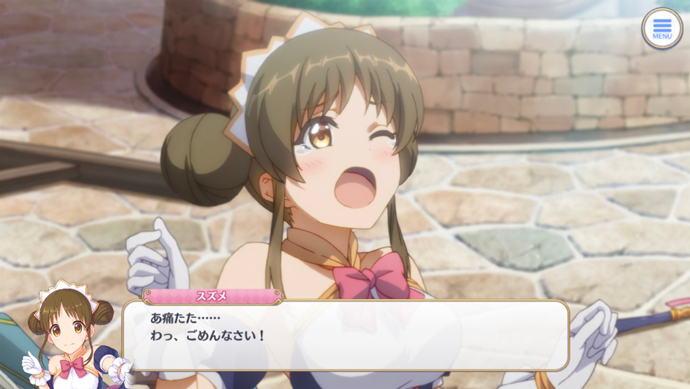
Naoko: Short animations that are 60–90 seconds in length started to be the norm ever since “Dangerous Vacation: Gourmet Princesses on the Beach” (end of June, 2018).
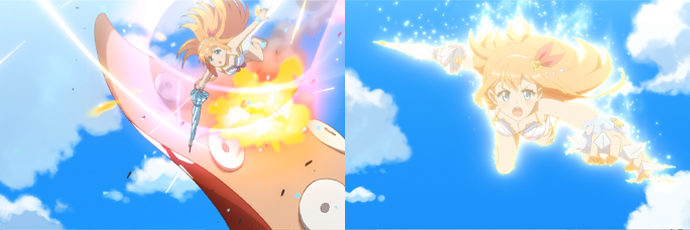
Masatake: The monster team started making reference files for the animations around the story event for July, 2018.
Naoko: Then we started putting two short animations in one event,
starting with the story event “Super Dash! Landsol Guild Race” (end of December, 2019). When we only had one animation per event, it would usually be a battle scene, so we talked about wanting to add regular scenes for the characters.
PCR keeps getting plenty of new content. Has the production structure changed at all to accommodate that?
Natsuko: Around the time we were making “New Year Twinkle Crisis!”,
our internal animation production structure started to get more streamlined. I actually come from an animation industry background, so I was doing the animation artwork concepts up until “The Black Iron Ghost” (end of August, 2018). (Laughs)
Naoko: I forgot about that! At the time, more people from an animation background joined the team, including myself. That’s when we became a dedicated team. We gradually started animating more and more things, and now we’re the size of a small-scale animation company.
Are all of the animations created in-house?
Naoko: We can do most of it in-house since we have employees who can shoot footage and finalize animations, but a few other companies help us with the sheer volume of work we need to produce. Our subsidiary, CygamesPictures (CyPic), is one of those companies.
We have to maintain a certain level of quality even if the production teams are different, so we make concept reference files to show each character’s particular features to avoid discrepancies between individual work. We also oversee and organize artwork from the production leads and ask for revisions so that everything stays uniform.
Adding an air of mischief into the cute world of PCR.
Please tell us about what each team does to make the in-game world so charming.
Wao: PCR has many different characters, and each character is highly unique. I’m careful to make sure that each character stays true to their personality. If a character acts unusually, players who like that character will notice that something isn’t right. At the same time, if a character is too rigid, then they lack depth. So, for example, we’ll show a different side of a character if their friendship level with the player is higher because of an event.
Take Makoto, for example. She is supposed to be a strong-minded character, but her swimsuit version that was shown in the story event “Midsummer Maho-Maho Kingdom” (end of July, 2019) showed her bashful side in her expression and pose. Since we were making her a little different from her normal characterization, we wanted to show a different side of her that’s confident, but a little shy. We discuss how far we can take a character with the scenario team before anything is decided.
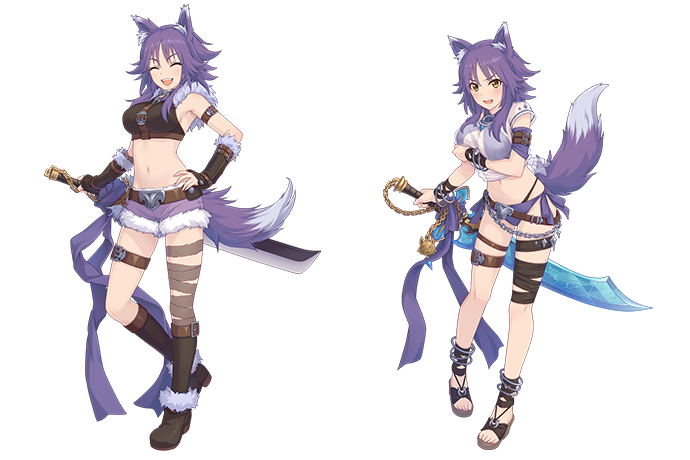
What about the monster team? You talked a bit about this at your CEDEC 2019 presentation.
Masatake: The main idea is to avoid betraying the cuteness of the PCR world. We aim to design all the monsters to look cute and interesting. We also focus on making their movements humorous so the user thinks, “What the heck is this thing?” when encountering a monster for the first time. On the other hand, the monsters need to be convincing as living creatures, so we try to design them as actual characters.
What do you mean by “convincing as living creatures”?
Masatake: Take, for example, the Lantern Bug monster that appears in normal quests. Since it lives in the forest, we designed it to be a type of insect with a lantern on its bottom, giving it a firefly motif. Then, we expanded on the idea by changing its lantern into the shape of a lantern flower, making it more unique.

What are you mindful of when creating background artwork?
Natsuko: As with the monster designs, maintaining the cuteness of the PCR world is very important. It’s a fantasy setting, but we design the backgrounds to be convincing and acceptable so that players feel like they’re really in this world.
We’re also careful about our color palette choices, and we discuss what colors to use with our color supervisor to make the characters stand out.
At the same time, we aim to create a world that looks exciting to explore, and for people to think that the colors look appealing when they first view an image.
We’re always thinking about how to create something in the PCR style. If we get a request for a forest scene, we try to make it something more than your average forest. Sometimes we sneakily put little Easter eggs in the backgrounds. It’s always a delight when the artwork is approved.
Masatake: We add Easter egg details in the monsters, too. It’s no fun just making what is requested, so we discuss things with the planners and add fun little elements here and there. We want to create a fun world.
Natsuko: Monsters and backgrounds are often linked together, so to make a monster convincing as a living creature, as Masatake said earlier, it’s important to create backgrounds that really seem like their habitat. We’re always consulting people on the monster team so that our respective designs work well together.
In a desert scene, for example, we drew monster footprints in the sand to make it look like the monster was returning to its nest… Some people don’t notice these details, but we still put them in. (Laughs) I think that’s what maybe creates a sense of excitement when players first look at the picture.
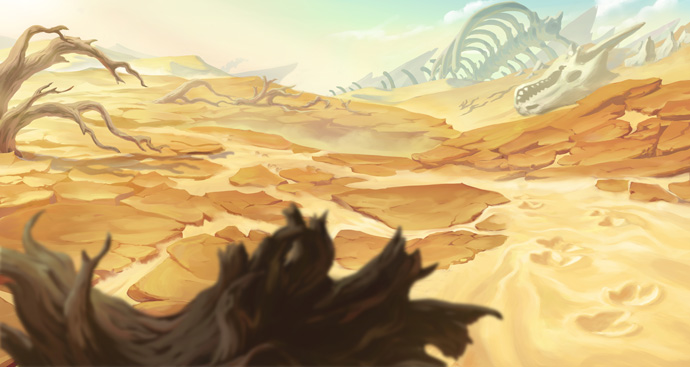
Paying attention to detail to make things fun! All of the teams encourage playfulness.
I can see you put a lot of thought into the details. Are the other teams similar?
Wao: I think so. All of the teams do their work playfully. I think it’s boring to just do what you’re told, and I appreciate that our art director lets us come up with fun ideas.
Natsuko: Sometimes he even adds on to our ideas, saying, “You should make it more like this!” And we add these details, knowing full well that we’ll struggle with the schedule later. (Laughs)
Naoko: That happens in all of the teams.
Masatake: When we create a monster with an unusual design, the animation design team seems to like expanding on those ideas.
Wao: It’s a great work environment. It feels like we all value a sense of playfulness.
Naoko: I think if people only do as they’re told, they start believing that they can’t try anything new.
Masatake: Though it does make our schedule tighter. (Laughs) But as a creator, I find this process very rewarding, where our overall quality improves when someone’s fun idea invites more ideas.
Please give us more examples of being sneaky, aside from the desert scene you mentioned earlier!
Masatake: I have a good example from a more recent event, “Dragon Explorers” (end of October, 2019). A boss monster called Imposter Dragon lived in its lair and had a habit of collecting things. The monster team and background team talked it over and decided to have its nest littered with things that had been in its pocket. Among those objects, as an Easter egg, we added a feather from the boss monster, Dizz, from a past story event called “Hatsune’s Present Plans” (end of March, 2018).
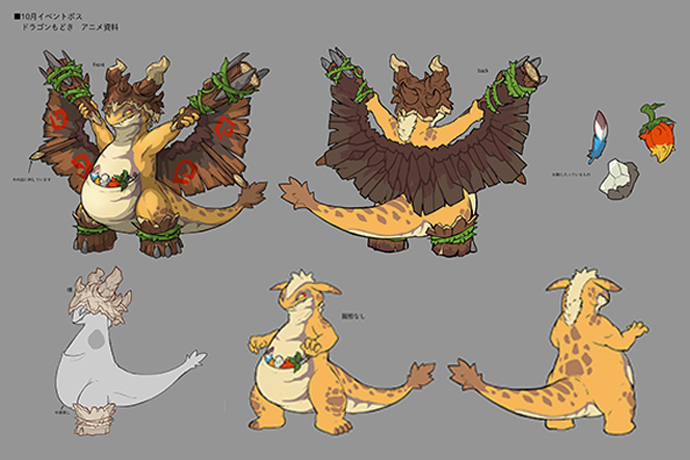
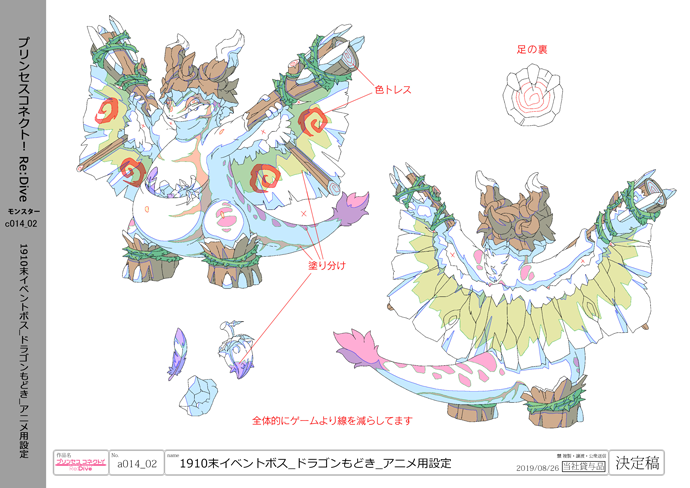
Natsuko: Also in the background, you see fruits that Imposter Dragon had been eating so it could breathe fire. We shared lots of ideas with the monster team, like “What kind of juice comes out of those berries when they’re bitten?”, and “Since it catches fire, maybe it’s an oily substance?”
(Laughs)
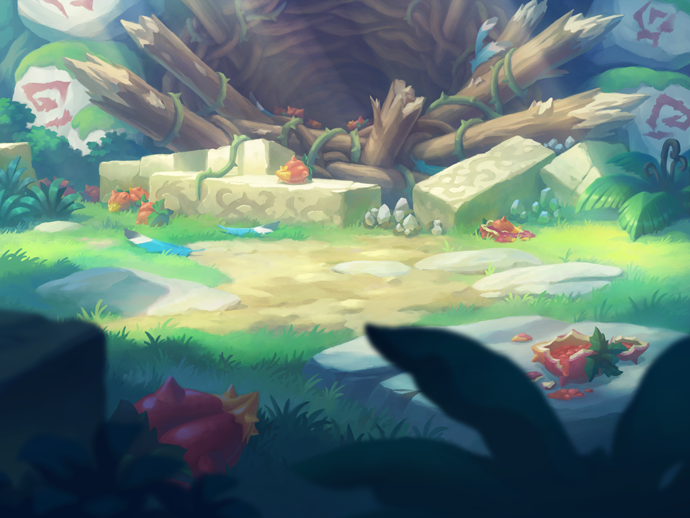
Natsuko: Another time, for “The Coward in the Forest and the Academy Dissenter” (end of August, 2019), we snuck in a chibi version of the boss monster Giant Poison Mandragora in a textbook. We also added a map of the Astraea continent in the upper left corner.
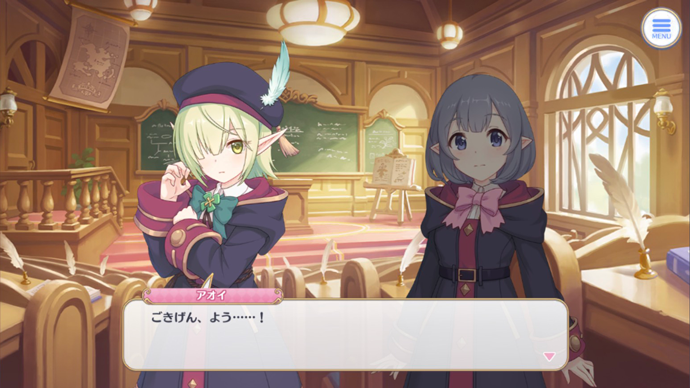
Naoko: As for characters, many 3★ character illustrations have Ayumi lurking in them, so players can have fun spotting her.
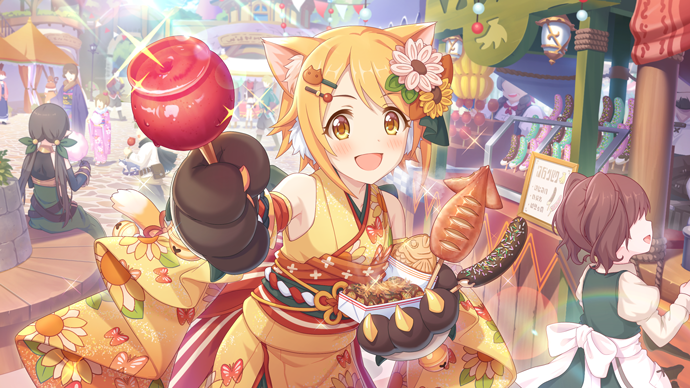
It is fun to hear about these, because some of them aren’t noticeable until they’re mentioned! Players must have fun noticing these Easter eggs. What kinds of things do you keep in mind when creating animations?
Naoko: Animations have to be consistent, so we are much stricter about character and monster heights, building dimensions, etc., compared to the rest of the game.
Each character has a set height, so sometimes we slightly alter the proportions from their still illustrations, or adjust their accessories like hats and high heels, so that their heights are accurately depicted in the animations. Unlike their in-game images, the characters’ full bodies are often shown in animated scenes.
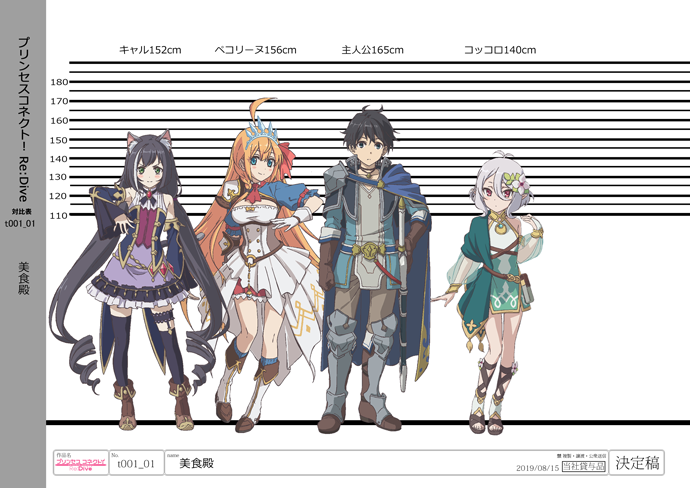
That’s true. Sometimes the height differences between characters in the animations are surprising. Sometimes their heights juxtapose their personalities, too.
Naoko: Like how Aoi is actually taller than Hatsune (*Hatsune is 156 cm and Aoi is 158 cm). The art director also thought that Aoi was petite, so when I drew things to scale and showed him for the first time, he went, “Huh?” (Laughs)
Wao: Then there’s Christina, who’s smaller than she seems. There are quite a few characters who would surprise you.
Aside from height, are there other aspects you struggle with or need to alter?
Naoko: One thing would be facial expressions. We try to prepare reference materials of character facial expressions beforehand, such as what characters would look like when viewed from a lower vantage point, or what they’d look like when they’re angry.
The other thing would be how the characters move. Even if they’re just standing, Yui would stay centrally balanced with her legs turned slightly inward and her arms close to her body, while Christina would have her toes pointed outward and she’d stand boldly with her chest forward. Each character’s pose is different depending on their personality. When they walk or run, they all have different ways of swinging their arms, and different stride lengths. We’re mindful of having the characters act like themselves.
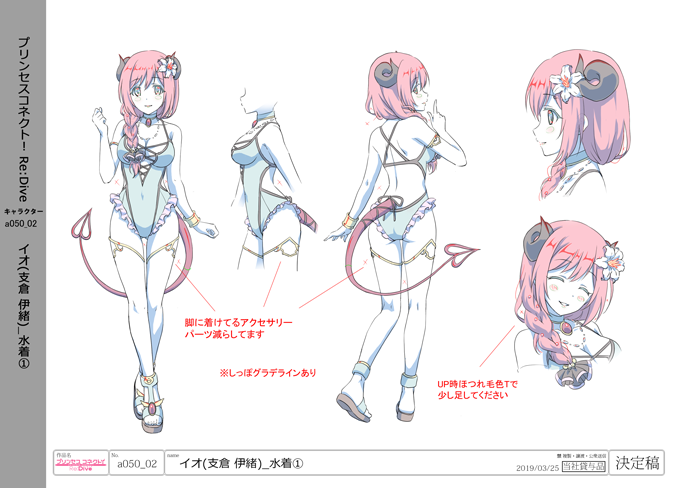
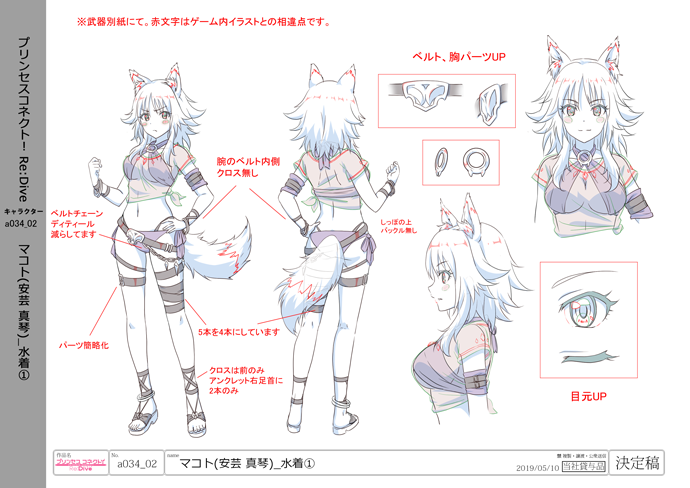
Naoko: Since there are so many characters, sometimes we aren’t able to communicate all the details to the other companies beforehand, so we have to revise what they submit to us or send messages in writing such as, “Please have the character stand like this,” or “Please tone down their facial expression.”
You must have to check the small conceptual details and provide supplemental data, since the information prepared for the game alone isn’t enough to maintain consistency.
Naoko: Yes, that’s right. Camera angles change a lot in the animations, and the characters move, so the underside of clothing and the like are often visible. So we have to ask, “Is there a pattern on the underside of this fabric?” Or, “What material is this part made of?” They might think we’re like weird creatures that can only ask, “What about this part?” (Laughs)
Compared to in-game illustrations, animations need to be simplified and use fewer lines. We need to know about materials and textures so that we can reduce the number of lines drawn or use shadows in the place of lines where possible, without changing the impression of a character.
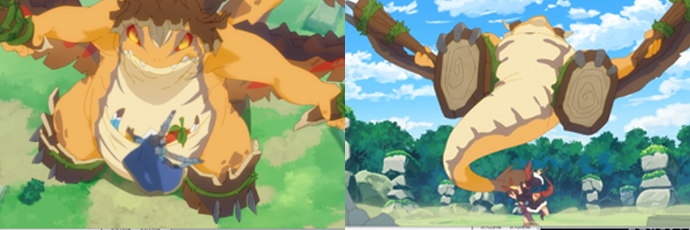
So for the animations, you make sure to know the important aspects and then reduce the amount of drawn information.
Naoko: That’s right. Take, for example, the boss monster Majimun in the “Midsummer Maho-Maho Kingdom” story event (end of July, 2019). We matched the position of its broken fang to its in-game illustrations, but we decided against drawing any of its scales.
We reduce the amount of drawn information without changing the character’s impression and consult other teams to decide what elements to draw and what elements to use textures for instead. This decision-making happens in the planning stages. It’s done this way because the animation process often requires a lot of painting and rendering.
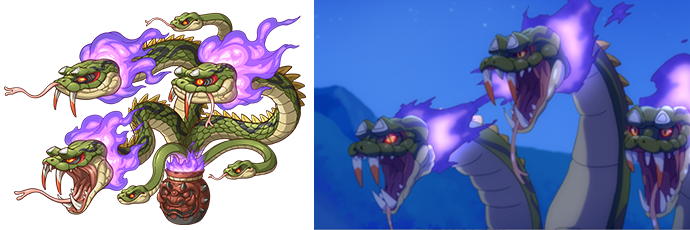
We all just want to please the players! What moments are the most rewarding?
Please tell us about the most rewarding thing about being involved with PCR.
Wao: I feel like all our hard work was worth it when our creations finally reach the players. It makes me so happy to see things like fan art, knowing that players are exploring the PCR world.
And, honestly, I’m just really happy when I get to see my character designs move. Only with PCR can I get to see a character I designed as an animation just a few months down the line. (Laughs)
Natsuko: It’s a very quick turnaround!
So, there’s a special thrill in seeing your characters animated apart from just having them in a game then.
Naoko: The monster team is always sharing their excitement with us too. (Laughs) They say, “We’re always looking forward to the animations!” And then we’re like, “We’ll do our best!”
Masatake: Other games don’t show off their monsters like this. We feel like proud parents, seeing our children move. (Laughs)
I think I know what you mean! Does the monster team struggle with anything?
Masatake: A specific problem for the monster team is that everyone has different opinions on how gross something looks. So sometimes it’s difficult to decide how far to take things.
For example, some people thought the boss Ugly Lovely, who was in the story event “Battle of Valentine” (end of January, 2019), looked cool like a dinosaur, while others thought it looked like a zombie and was disgusting. It even divided the production team. Since the production side can get divided on such things, we have to make decisions on a case-by-case basis.
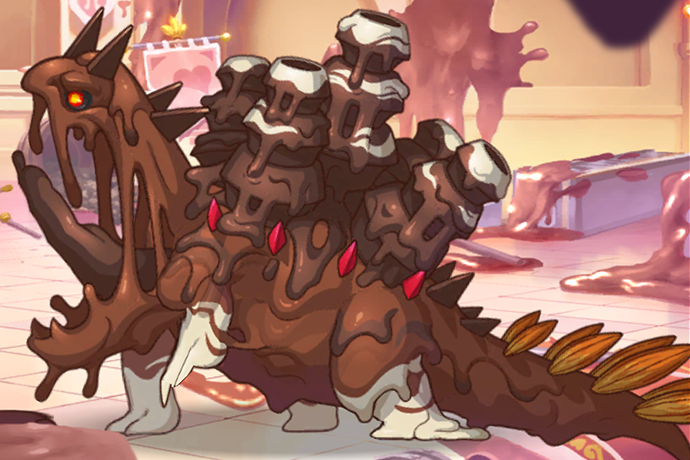
What about the background team?
Natsuko: We have similar issues because of personal preference. The PCR world is cute, but there’s also a serious side to it as well. We need to bring out that atmosphere in the background art, but it would turn into a dark fantasy genre if we overdo it. We worry about how far to push it.
One example is last year’s story event “Little Brave Halloween Night” (end of September, 2019). The setting was a haunted house surrounded by graves, and the boss was an overbearing father attached to his daughter even after his death. On paper, it sounds like a serious horror story. We struggled with balancing the cute charm of PCR and the darker aspects as to not turn it into straight horror. It seems difficult to strike a balance between the PCR world and its stories. But if the finished product is good, then I feel like the hard work paid off.

Do you have a sort of formula, or set of rules, for creating the uniquely cutesy vibe in PCR?
Natsuko: We try to make Landsol, the central setting for PCR, generally seem like a fantasy-style theme park, filled with a lot of chibi designs and vibrant colors. We try to make it look intentionally artificial, in a way. There’s also a “real” world in PCR that we try to make look as realistic as possible in its shapes and colors. We want people to tell the difference between the imagined and real worlds at a glance.
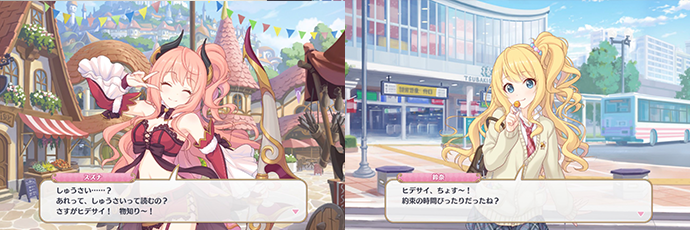
I see! And what about the animation team? You told us about some difficulties you had before, but what about things that made you happy?
Naoko: I think maybe when we get to see players’ reactions. I’m always encouraged when I see reaction posts on social media! In our company’s internal communication tool, we have a channel (chat room) to freely talk about PCR, and I get excited when an animated scene is captured and posted there.
I feel like people posted a lot of screenshots of the scene from the “Twilight Breakers” story event (end of October, 2018), where Eriko is walking and dragging her axe. I’m actually a big fan of Eriko and I enjoyed directing her scene, so I’m happy if it left an impression on players. If her crazy demeanor got across, that’s icing on the cake. (Laughs)
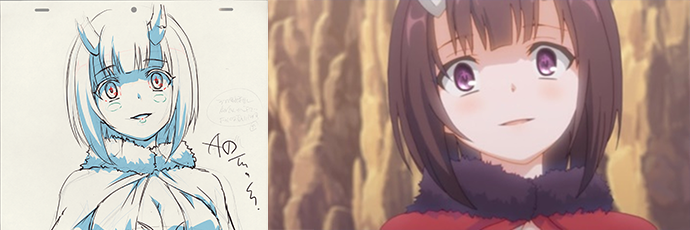
In Part 2, we ask about the team’s most memorable characters, events, and production stories from the climactic special event of the first part of PCR, “Decisive Battle at the Capital” (December, 2019). Don’t miss it!



